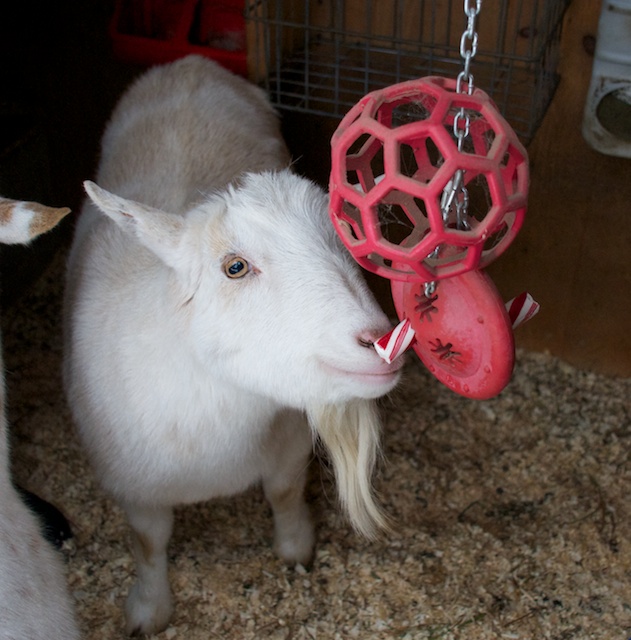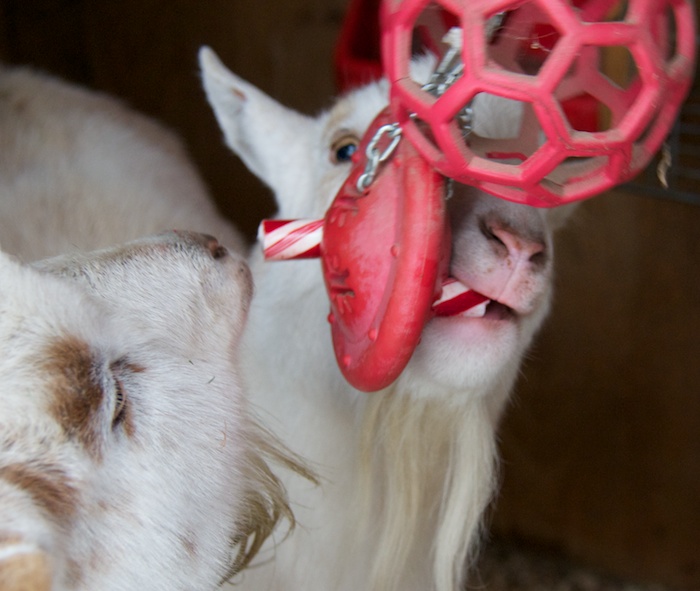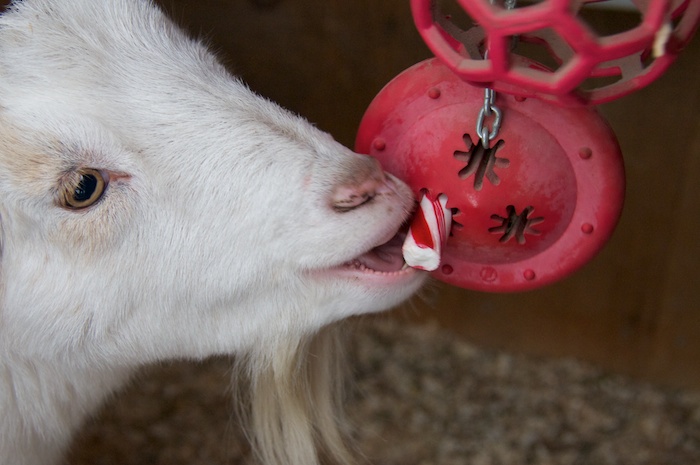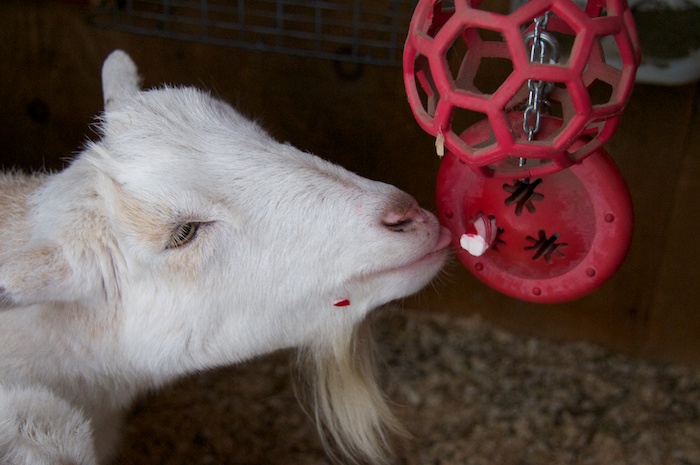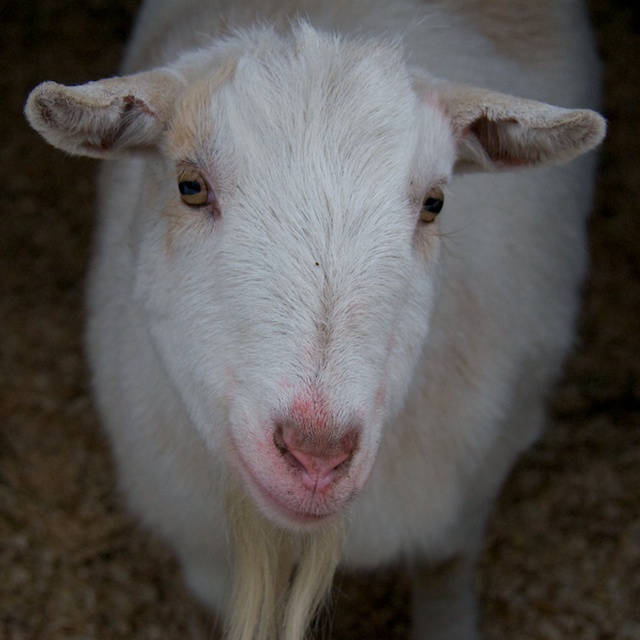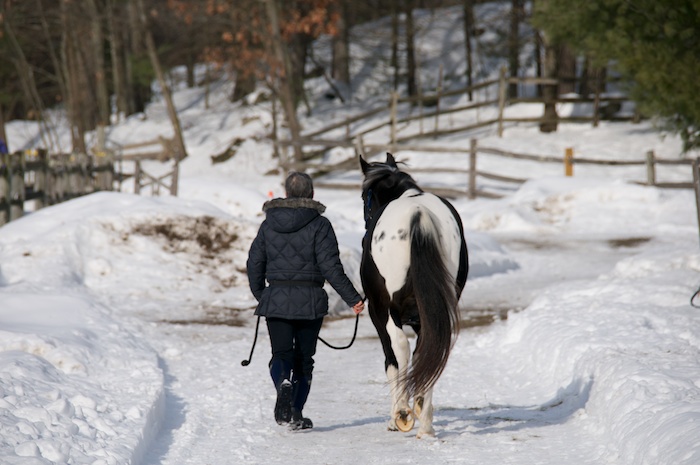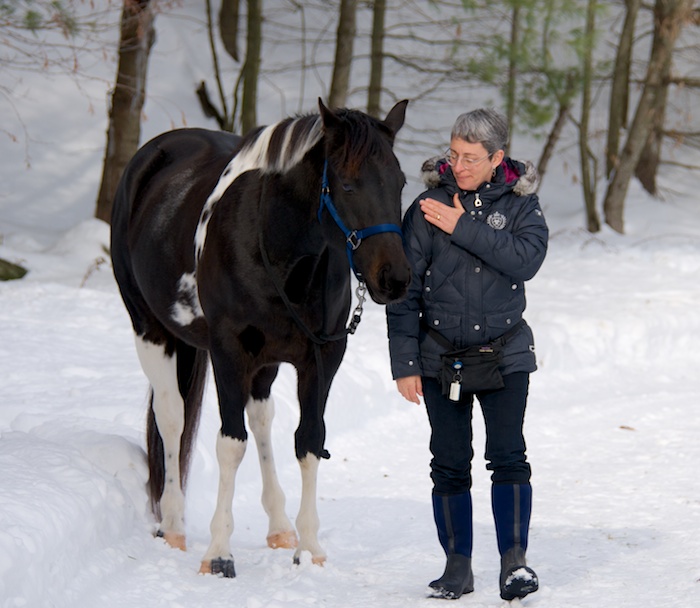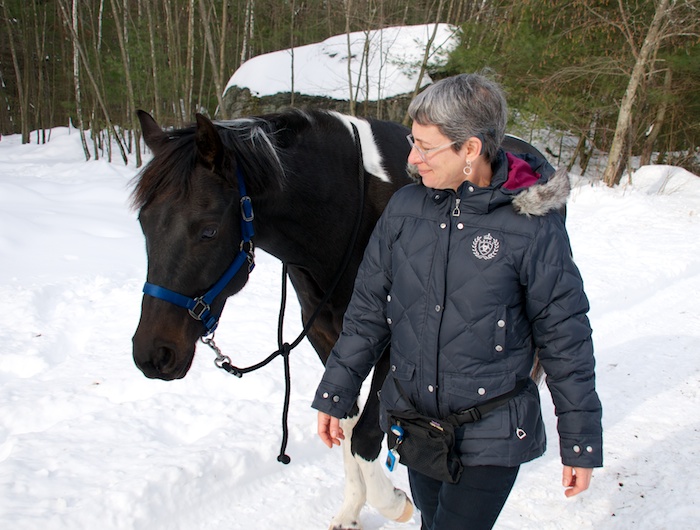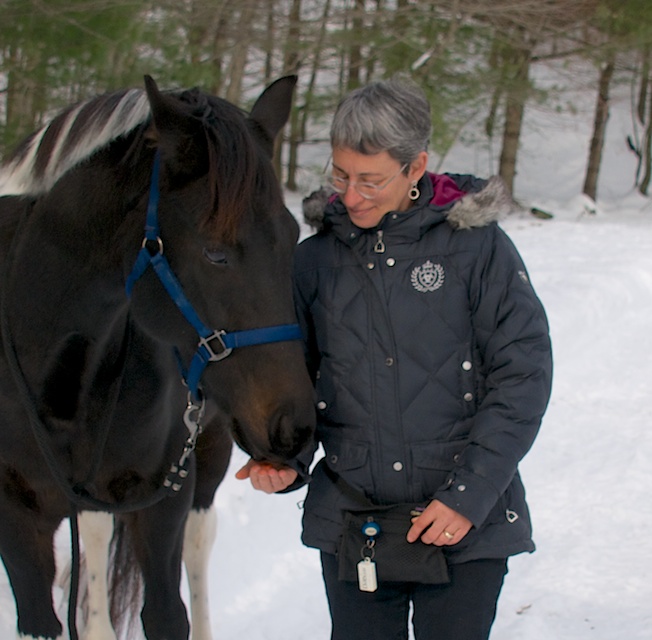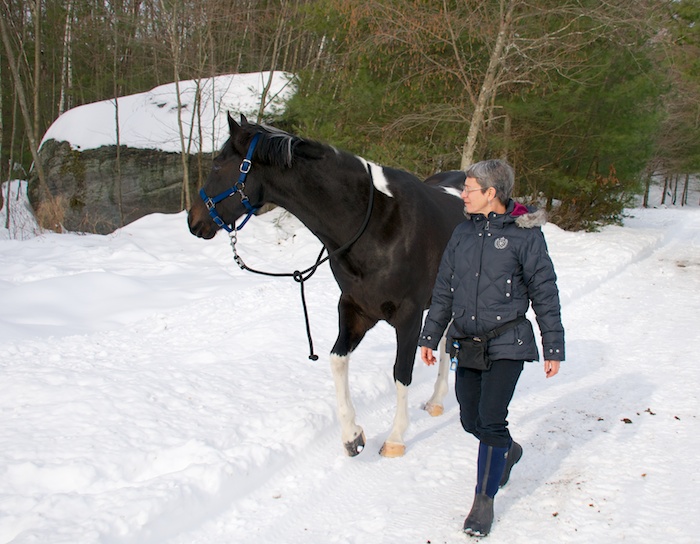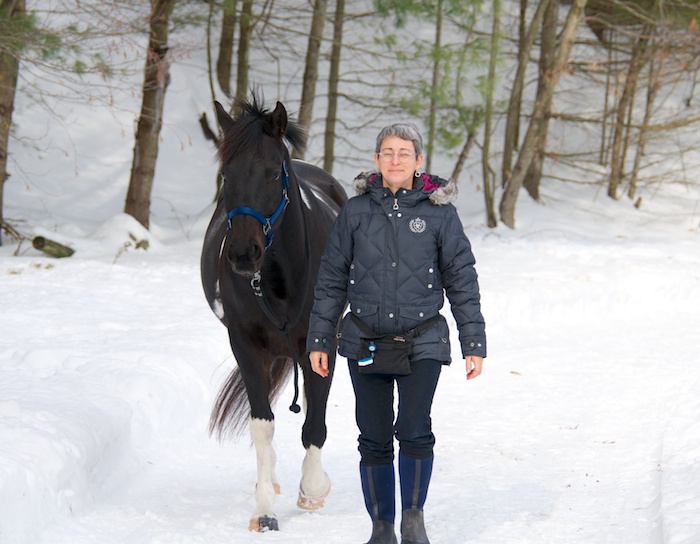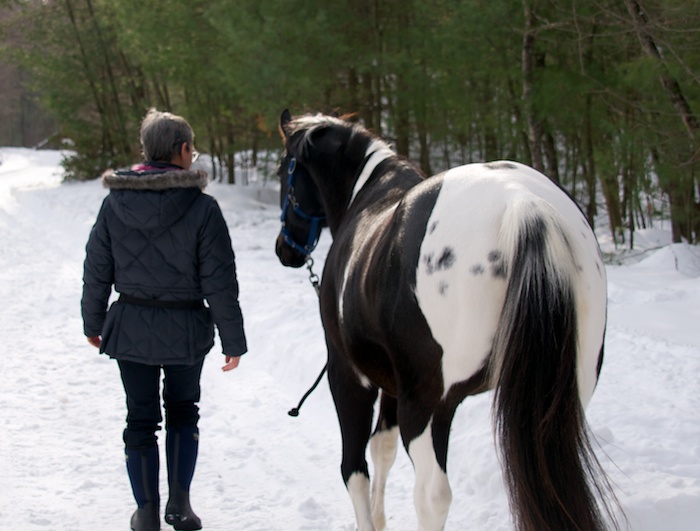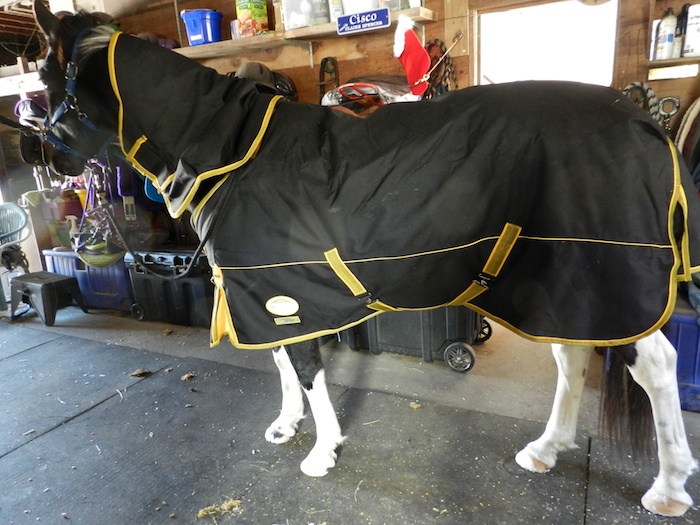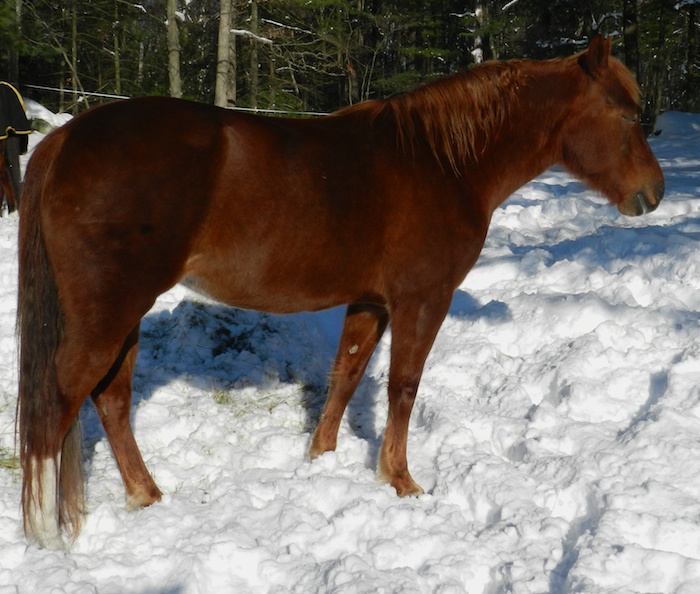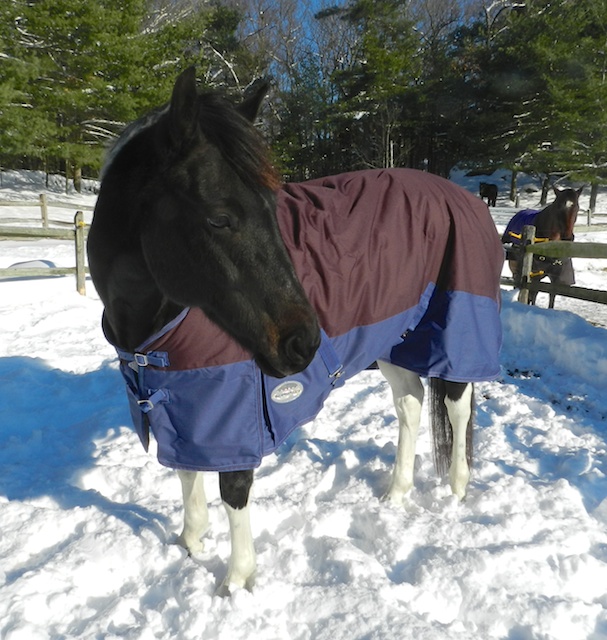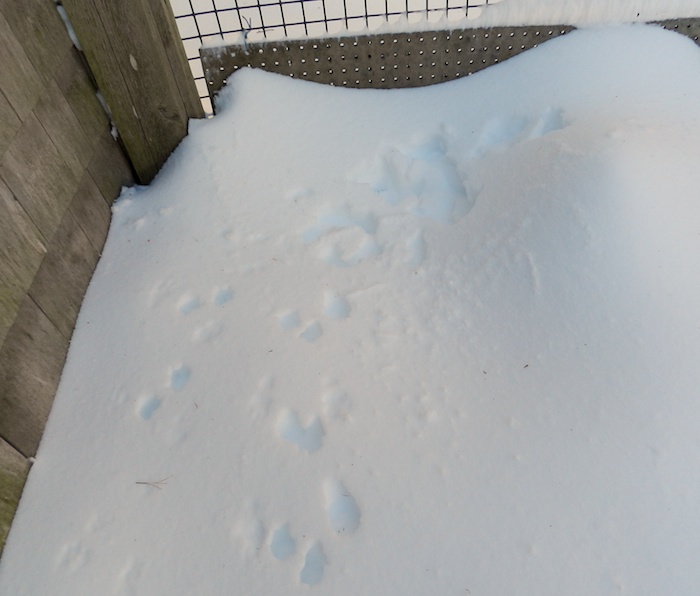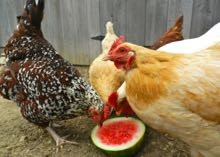I’m starting 2014, not with a post about chickens, but with a bit of miraculous beauty to set the tone for the New Year. This is a video that Steve took last summer while in Iceland with four Boy Scouts on a high adventure trip. This was filmed one evening at Skaftafell campground. The tents are lit by the rising moon, and the aurora borealis dances in the sky.
Peppermint Stick Goat
I was given a large peppermint stick. I had an idea of who might like it.
As expected, Caper took a sniff and declined, but Pip was game to try a new food that smelled like his favorite herb.
The hanging toy is supposed to make it a challenge to eat a treat. Pip was up to it. He crunched.
He nibbled.
He licked. He got bits of candy stuck to his beard.
Is this how Rudolph’s nose got so red? Alas, Pip still can’t fly.
Merry Christmas!
I’m taking a week off from this blog between now and January 1. I’ll be staying away from the computer and spending time with my family. I’ll catch up with you in the New Year.
Why I Clicker Train My Horse
Tonka walks nicely next to me with a halter and a lead line. Horses are trained to do this with corrections – if a horse gets too far ahead, the handler tugs on the line, if the horse balks, he is slapped on his side or his head is yanked. If a horse gets too full of himself, a more severe halter might be used, or a chain is threaded across the nose. None of this is necessarily horrible. In the hands of a good trainer, corrections are quick, and a horse learns to walk placidly, and without fear, next to his handler.
However, I aim for something better than that. I want Tonka to walk next to me because he chooses to. I want him to pay attention to me. I want him to walk next to my shoulder, a foot away, looking forward and content to be where he is. I can get this behavior from Tonka without a single correction or even a no. I do this with clicker training.
A clicker is a small noise maker. Press down with your finger, and it makes a distinct click. I use this sound to tell Tonka exactly when he is doing what I want. Tonka knows that a reward will follow. (In his case, it is a carrot coin, but rewards can vary. However, a reward must always follow the click.) Clicker training allows me to communicate very clearly with Tonka. I start with a well-defined end goal, then think through what the first thing is that is needed to get there, and then what’s after that. For example, if my goal is to get Tonka to come when called, at the beginning of training this I’m not going to wait to reward him until he is galloping across a field towards me. The first click comes when he looks at me, then a step, then another. This sounds slow, but actually, because I am communicating precisely and building on each success, the training goes quickly.
So, back to the walking off-lead work. My goal is for Tonka to walk on my right side, matching my pace, without the use of a lead line. I decided that I would tell him to do this with a visual cue of my left hand tapping on my right shoulder, and an oral cue of “let’s go.”
I set him up for success by doing this on the track that circles the pastures. Right now, with snow on the ground, there’s no distraction of grass to eat. There’s one stretch that is a spooky place, so I don’t work him there. I’ll wait to drop the line at that corner only when he is 100% elsewhere.
At the first session of teaching this off-lead work (similar to off-leash work with dogs) I clicked and rewarded for just a step. Then three. Soon I could space out the clicks, and In short order, Tonka was walking at my shoulder for a half-minute up the track.
I keep the carrots in a bag around my waist. Tonka never gets a treat just because I love him, (even though I do) because horses believe that all behavior is correlated to other behavior. If a horse nudges you once and gets a treat, the next time he sees you that nudge will be a shove. Training goes both ways, and happens whether you mean it to or not. Treats without reason lead to pushy horses. Horses are powerful animals. I never reward for anything (no matter how cute) that can turn into dangerous behavior. A nuzzle of the treat bag can easily turn into getting slammed with a horse head. If, during training, your horse “mugs” you, revise your training protocol! In the context of off-lead work, Tonka gets rewarded only when he is looking forward.
Horses thrive on relationships and interaction. Everything they do in a herd has a cause and effect. Humans can be so confusing for horses because so much of what we do doesn’t appear to correlate with anything that they’re communicating to us. But, this clicker stuff (when done right, and sadly it’s done very badly by some), is quite clear to them. Also, horses like to have a say in things. From Tonka’s perspective, he’s telling me what to do. “I put my nose here and step here and you give me a carrot. Hah! Look what I can get you to do!” Horses don’t like to be coerced, either. If Tonka doesn’t walk perfectly next to me, if he swings his head to look at something, or if he lags behind, nothing happens. Nothing. No tug. No shouting.
I wait. He thinks about things. He goes back into position, and the moment he does so he hears a click. Then he gets his reward (If you reward without the click, you lose the precise communication. By the time you hand over the carrot, the horse has already done something else.)
I’ve been doing this training for a week, and have done only six sessions, each one lasting less than fifteen minutes. Tonka is now walking freely next to me, and slows down or speeds up according to my pace. If I back up, so does he, to keep his head at my shoulder. This sort of training makes the horse happy. I don’t think I’m anthropomorphizing here. I can see it in Tonka’s relaxed posture, in his forward ears, and in how he is engaged with me without any worry in his eyes.
Horses are hyper-aware of their bodies and the world around them. Tonka has come to learn that I’ll respond to his body language sanely, and that what he does matters to me. As he learns to trust me, I learn to trust him – that he will think and pay attention to me. This sort of training is gratifying to both of us, and should reap rewards in the future when we’re on the trail. Tonka will trust that if I ask him to do something (cross a bridge, or ford a stream, or walk by a scary boulder), that I’m listening to his concerns, and he’ll believe me when I say that it’s okay to go on.
For now, the trails are too icy to ride, but we have a lot of things to work on, Tonka and I. I’m beginning to see how gentle and thoughtful my gelding is. I also see a glimmer of a sense of humor in how he responds to training. That’s another thing about clicker training – the full personality can come out when the lines of communication are open.
Dressing Warmly
My son waits for the school bus early in the morning, when it is still dark. The other day he left the house wearing his lightweight warm-up jacket. He did not wear gloves. It was -4 degrees F. He said he was fine.
Tonka does not have the option of being a teenage boy and refusing to dress warmly. A storm was predicted, and so I put on his extra-cold weather gear. He looked a bit like a fireman. Or a bumblebee in armor.
Unlike my teenage son, he didn’t seem to mind my fussing over him, or getting dressed.
Like most of the horses at Little Brook, Tonka lives in a field. A 3-sided shed provides protection from the worst of the weather.
For many horses, like Tonka, this is a healthy alternative to stall life. Some horses don’t even need blankets. Cricket, despite his advanced age, grows a thick coat that amply protects him. I can tell he’s just fine by that glowing patch of dapples across his rump. A patch of sun, and he’s cozy enough for an afternoon nap.
Tonka doesn’t have Cricket’s thick fur, so I do have to blanket him. But once the storm passed, I swapped his heavy-weight for a lighter turn-out blanket.
Temps are predicted to rise into the high-40s later this week. Tonka won’t need any blanketing then. Most likely my teen will wear a t-shirt to school.
